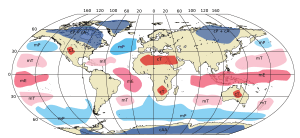Air mass facts for kids
An air mass is a huge chunk of air that has a similar temperature and amount of moisture throughout. Imagine a giant bubble of air, sometimes covering thousands of square miles! These air masses get their characteristics from the areas where they form. When an air mass moves, it brings its weather with it, changing the conditions in the places it travels over.
Contents
What is an Air Mass?
An air mass is a very large volume of air. This air has a fairly uniform temperature and amount of water vapor. Think of it like a giant blanket of air. It can cover hundreds or even thousands of square miles.
Air masses get their properties from the surface they form over. For example, an air mass forming over a cold, dry land will be cold and dry. One forming over a warm ocean will be warm and moist.
When an air mass moves, it carries its temperature and moisture with it. This is why air masses are so important for understanding weather. They are a main reason why weather changes from day to day.
How Do Air Masses Form?
Air masses form in specific places called source regions. These regions are usually large and flat. They have a uniform surface, like a big ocean, a desert, or a frozen ice cap.
For an air mass to form, the air needs to stay over its source region for a while. This allows the air to take on the temperature and moisture of that surface. For example, air sitting over the Arctic for days will become very cold and dry. Air over the warm Caribbean Sea will become warm and humid.
Types of Air Masses
Scientists classify air masses based on two main things: their temperature and their moisture content. The temperature depends on where they form (near the poles or the tropics). The moisture depends on whether they form over land or water.
Temperature Classification
- Polar (P): These air masses form in colder regions, usually between 50 and 60 degrees latitude. They bring cooler temperatures.
- Arctic (A): These are even colder than polar air masses. They form over very high latitudes, like the Arctic or Antarctic. They bring extremely cold weather.
- Tropical (T): These air masses form in warm regions, usually near the Equator. They bring warmer temperatures.
Moisture Classification
- Continental (c): These air masses form over land. They are typically dry because land doesn't have much moisture to give to the air.
- Maritime (m): These air masses form over oceans. They are typically moist because they pick up a lot of water vapor from the sea.
Combining Types
By combining these two classifications, we get four main types of air masses:
Continental Polar (cP)
- Where they form: Over cold, dry land areas, like northern Canada or Siberia.
- What they bring: Cold, dry weather. In winter, they can bring very cold temperatures and clear skies. In summer, they might bring cool, pleasant days.
Maritime Polar (mP)
- Where they form: Over cold ocean waters, like the northern Atlantic Ocean or Pacific Ocean.
- What they bring: Cool and moist weather. They can bring clouds, fog, and rain, especially to coastal areas.
Continental Tropical (cT)
- Where they form: Over hot, dry land areas, like the deserts of the southwestern United States or the Sahara Desert.
- What they bring: Hot and dry weather. They often lead to heatwaves and clear skies.
Maritime Tropical (mT)
- Where they form: Over warm ocean waters, like the Gulf of Mexico or the western Pacific.
- What they bring: Warm and moist weather. They are often responsible for humid conditions, thunderstorms, and heavy rain.
How Air Masses Affect Weather
When an air mass moves, it changes the weather in the area it travels over. For example, if a cold, dry continental polar air mass moves into a region, the temperature will drop, and the air will become drier.
The boundaries between different air masses are called fronts. When two air masses meet, they don't mix easily. Instead, one air mass often pushes the other, creating weather changes like rain, snow, or thunderstorms. This is why understanding air masses is key to forecasting the weather!
Images for kids
-
Lake-effect snow bands near the Korean Peninsula
See also
 In Spanish: Masa de aire para niños
In Spanish: Masa de aire para niños





